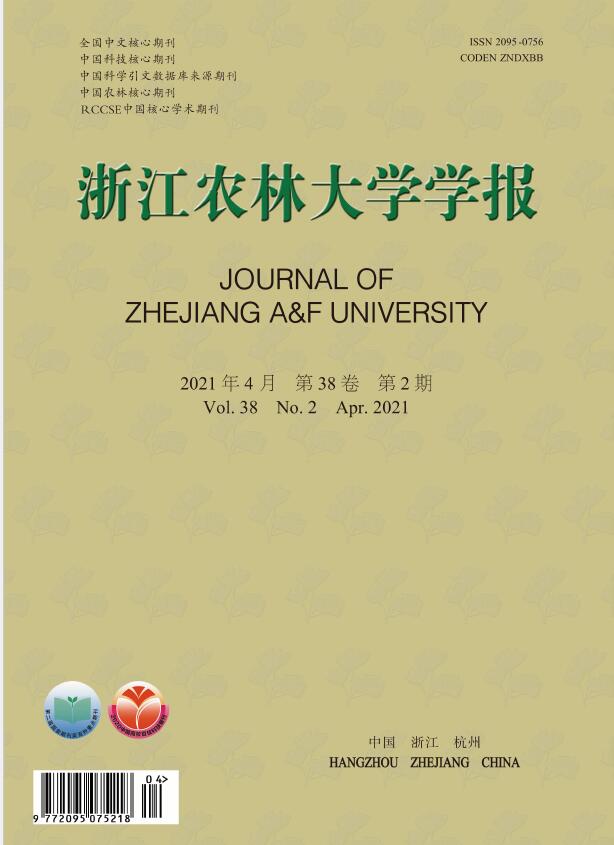-
十字花科Brassicaceae植物多为1年生或多年生的草本植物,包含小白菜Brassica rapa ssp. chinensis、甘蓝Brassica oleracea var. capitata、油菜Brassica napus、萝卜Raphanus sativus等蔬菜作物,还有二月兰Orychophragmus violaceus等观赏植物,以及板蓝根Isatis tinctoria等药用植物等。十字花科植物中富含叶绿素,且叶与茎中的叶绿素远高于其他色素,因此外观上呈现绿色,但在彩叶植物或者叶绿素缺失植物中,由于其他色素大幅增加或叶绿素大幅减少而呈现彩色或黄色等。植物中存在着数量巨大的各类突变体,常作为研究植物生理生化机制与基因组功能的重要材料[1-3]。其中一类叶绿素缺失,植株表型黄化的突变体,称为黄化突变体[4-5]。由于黄化性状易观察,可以直观呈现植物体内叶绿素的多寡,且影响植物光合作用及生长发育,因此黄化突变体是研究叶绿素合成代谢的优良材料。本研究对十字花科植物中发现的黄化突变进行分类,总结黄化突变体形态结构及光合色素含量的变化规律,探求黄化形成原因与分子机制,归纳黄化性状遗传模式,为十字花科植物的叶绿素代谢及叶绿体发育等研究提供参考。
HTML
-
十字花科植物中已发现多个叶绿素缺失导致的黄化突变体。小白菜自交系‘564’和品种‘寒青’‘Hanqing’、‘华冠’‘Huaguan’中均发现黄化突变体[6-8]。杨冲等[9]从意大利引进的甘蓝杂交种Hosom自交分离后代中发现叶色黄化、植株矮小的突变体YL-1。杜江涛[10]和侯爱琳[11]对大白菜Brassica rapa ssp. pekinensis DH系‘FT’进行甲基磺酸乙酯(EMS)诱变,分别获得了稳定的黄化突变体lcm2、lcm3。通过自发突变、EMS诱变、氮离子束处理等方式,甘蓝型油菜中也获得了多个黄化突变体,如ny、bnaC.ygl等[12-15]。杨胜洪等[16]发现:抽薹期的油菜黄化突变体叶片的叶绿素含量和叶绿素与蛋白质比值只有野生型的一半。此外,FRICK等[17]发现:拟南芥Arabidopsis thaliana的porB-1porC-1双突变体在子叶期只含有少量的叶绿素a,形成了一个幼苗致死的黄色表型。
通过转基因技术也可获得黄化突变体。BANG等[18]研究发现:拟南芥CHL27-T敲除突变体生长迟缓,并且伴随着由叶绿体光系统Ⅱ的反应中心损坏引起的发育缺陷。PRIVAT等[19]发现:反义表达质体SIG2转录因子的拟南芥植物表现出叶绿素缺失的表征,并且只表现在子叶中。KUMAR等[20]通过反义表达HEMA基因,获得了表现出不同程度叶绿素缺失性状的拟南芥转基因植株,如叶片斑块状黄化和全株黄化。以上研究表明:黄化突变表现为植株全株黄化或部分黄化,且黄化性状可稳定遗传。
-
叶绿素是植物生长必不可少的光合色素,如果叶绿素缺失突变导致叶绿素完全不可合成,或叶绿素含量无法保证植株最低程度的光合作用,植株表现出白化,则易发生致死性突变。KOBAYASHI等[21]报道了1种类囊体膜脂质单氨基半乳糖二酰甘油(MGDG)合成酶1完全缺陷的拟南芥突变体,只在蔗糖存在的情况下才能萌发为细小的白化植株,且幼苗缺乏半乳糖,光合膜被破坏,光合能力受损严重。拟南芥白化突变体cfl1的真叶有白色坏死斑点,叶片发育畸形且不对称,叶边缘缺刻严重,生长缓慢,植株矮小,结实率低[22]。白化突变植株与黄化突变植株相比,叶绿素缺失更为严重,植株生长受到的影响也更大,甚至导致植株无法存活。
-
在目前发现的黄化突变体中,部分黄化突变体在生长过程中黄化性状减弱,植株随时间延长逐渐复绿。郭士伟等[7]发现小白菜黄化突变体在6叶龄前子叶和真叶均呈淡黄色,在6叶龄后又逐渐复绿,且不受环境影响。甘蓝型油菜黄化突变体ny在苗期前期叶片黄化明显,其后叶色缓慢转变,中后期及衰老期叶片复绿[23]。黄化突变体复绿原因现在还未完全探明,需要进一步深入研究。
-
多数黄化突变体表现出营养生长缓慢,生殖发育迟缓等现象。拟南芥CHL27敲除后的黄化突变体植株矮小,叶片均匀呈浅绿色,莲座叶弯曲,开花较晚,角果弯曲[18];lzf1突变体幼苗叶绿体发育延迟[24]。青梗菜是小白菜中一类束腰亮绿的优质品种,其564y突变体播种后5 d出现叶色差异,叶片黄化,下胚轴伸长,伴随植株细弱易倒,大部分生长指标明显低于野生型[6]。在甘蓝型油菜和芥菜Brassica juncea型油菜中发现的黄化突变体性状表现相似,均出现初花期推迟,花期较短等特点[8, 25]。甘蓝黄化突变体yl-1,虽然仍能结球,但单球质量只有对照的39.0%[9]。甘蓝型油菜黄化突变体Bnchd1,苗期叶脉间黄化,抽薹期薹叶呈淡绿色,整个生命周期内植株矮化,叶绿体形态异常并伴随着叶绿素提早降解现象,种子产量极低[12]。这些研究表明:黄化突变后植株的生长及发育阶段转变都受到不同程度的影响。
1.1. 黄化突变类型
1.1.1. 叶绿素缺失黄化突变
1.1.2. 叶绿素缺失白化突变
1.1.3. 黄化复绿突变
1.2. 黄化突变体表型
-
叶绿体由被膜、类囊体和基质3部分构成,若叶绿体的类囊体受到破坏,植物的光合作用及其他生理过程都会受到不同程度的影响。多数黄化突变体具有类囊体结构变异和基粒片层数减少等特征[26]。拟南芥FZL基因敲除突变体中类囊体形态异常,基粒堆叠杂乱,基粒和基质类囊体的相对比例发生改变[27]。烟草Nicotiana tabacum黄化突变体中叶绿体体积变小,数目减少并缺乏大部分类囊体膜,部分叶绿体表现出双重形态[28]。甘蓝型油菜的bnaC.ygl突变体与正常植株T6的叶绿体形状都呈正常纺锤状,但突变体叶绿体的基粒垛叠较少,类囊体膜也明显减少[14]。部分黄化突变体叶绿体中的嗜锇颗粒及淀粉粒含量也会发生变化。青梗菜564y突变体中叶绿体垛叠数明显变少,基粒片层结构难以观测,叶绿体淀粉粒数目较多[6]。甘蓝型油菜黄化突变体中,叶绿体的数量、形状、膜结构均受影响,且类囊体缺失,叶绿体内无淀粉粒,嗜锇颗粒较多,而复绿的叶片细胞内则与正常叶片表现相近[13],甘蓝型油菜突变体cr3529中也有类似特征[26]。吴砚农[29]对小白菜黄化突变体BcL14y-1和BcL14y-2研究发现:BcL14y-1黄化程度较轻,其叶绿体内类囊体垛叠数量有所减少,BcL14y-2黄化程度较重,叶绿体形状不规则,除类囊体垛叠数大量减少外,基粒片层排列混乱,嗜锇颗粒聚集,有过量淀粉粒囤积。拟南芥arc突变体的每个叶肉细胞只有2~15个较大的叶绿体,虽然叶绿体个数减少,但作为补偿,单个质体体积增大,从而保持叶肉细胞体积恒定[30]。OKAZAKI等[31]研究发现:拟南芥过表达质体分裂蛋白(plastid division proteins,PDV)后,叶绿体数量增加但体积减小,而PDV表达水平降低则出现相反结果。正常绿色植物的叶绿体成纺锤状紧贴细胞壁,基粒垛叠数较多且片层结构规整,有少量淀粉粒和嗜锇颗粒分布,而黄化突变植株的叶绿体则会出现不同程度的变异,导致这些变异的原因及分子机制需要进一步深入研究。
-
多数表现出黄化性状的突变体中,叶绿素含量显著低于野生型,而类胡萝卜素发挥了主导作用,因此叶片呈现出黄色表型。叶绿素包括叶绿素a和叶绿素b,在不同的黄化突变体中,两者质量下降幅度有所不同。陈艳丽[14]发现甘蓝型油菜黄化突变体bnaC.ygl中,叶绿素a和叶绿素b的质量分数分别下降了40.3%和57.7%,叶绿素a/b相较非突变品系T6显著提高,在其他不同的芥菜型油菜黄化突变体和甘蓝型油菜黄化突变体中也有类似表现[9, 18, 22-23]。在青梗菜黄化突变体pylm中,叶绿素a、叶绿素b质量分数分别下降了62.0%和75.0%,类胡萝卜素质量分数也下降了58.0%[8],叶片中的血红素显著上升[32]。大白菜黄化突变体lcm2的叶绿素a、叶绿素b质量分数分别下降了60.25%和70.91%[10],而lcm3的叶绿素a、叶绿素b质量分数则分别降低了33.0%和53.0%[11]。从前人研究结果可以看出:在各类黄化突变体中,叶绿素a和叶绿素b显著下降,尤其是叶绿素b,因此,叶绿素a和叶绿素b在光系统反应中的功能差异及其机制值得进一步研究。
-
光合作用的能力强弱与植物的生长发育及生殖阶段转变有关。在逆境条件下,叶绿素荧光参数也是衡量光合能力的重要指标[33],黄化突变通常缺失叶绿素,意味着光合能力降低。与野生型相比,青梗菜564y黄化突变体净光合速率显著降低,气孔导度、蒸腾速率稍低,胞间二氧化碳摩尔分数稍高,同时各项荧光动力学参数均降低[6]。油菜黄化突变体ny五叶期的净光合速率,心叶仅为野生型的57.96%,平展叶也只有69.62%,同时各项荧光参数显著低于野生型[23]。甘蓝黄化突变体yl-1在苗期时,净光合速率显著低于野生型,而随着植株生长,突变体逐渐恢复部分光合能力,但仍差异显著[9]。由于叶绿体结构改变及叶绿素含量降低,黄化植株的光合能力总体低于野生型植株。
2.1. 黄化突变叶绿体超微结构变化
2.2. 黄化突变体内光合色素
2.3. 黄化突变体光合性能
-
黄化突变体的叶绿素合成或叶绿体组成受到影响,多由核基因突变造成的。黄化突变中显性突变较少。TSANG等[34]构建的谷氨酸1-半醛氨基转移酶(GSA-AT)甘蓝型油菜反义构建体(GSA),T1代转基因株系中叶绿素含量减少,T2代转基因株系的幼苗分离为深绿色、浅绿色和黄色3种不同的表型,这表明GSA反义基因为显性遗传。
多数黄化突变为隐性突变,包括单核隐性突变和多核隐性突变2种类型。甘蓝型油菜黄化突变体bnaC.ygl的黄化性状由1对隐性核基因控制,为单核隐性突变[14-15]。芥菜型油菜突变体l638-y的黄化性状由2对隐性核基因GR1与GR2控制[25, 35];甘蓝型油菜叶绿素缺失突变体Bnchd1的黄化性状由2个隐性基因BnChd1-1和BnChd1-2控制[12];青梗菜黄化突变体pylm由2对隐性重叠基因(PY1和PY2)互作控制[8]。
-
黄化突变直接原因为叶绿素缺失,因叶绿素合成途径受阻所致。参考吴自明等[36]对被子植物叶绿素合成途径及反应所需酶的总结,整理出以谷氨酸和α-酮戊二酸为原料,依次合成L-谷氨酰-tRNA、谷氨酸酯-1-半醛、δ-氨基酮戊酸、胆色素原、羟甲基胆后色素原、尿卟琳Ⅲ、粪卟啉原Ⅲ、原卟啉原Ⅸ、原卟啉Ⅸ、镁原卟啉Ⅸ、镁原卟啉Ⅸ单甲酯、二乙烯原叶绿素酸酯、原叶绿素酸酯、叶绿素酸酯,最终合成叶绿素a和叶绿素b的途径。
这些中间产物由20多个基因编码的15种酶参与合成[37]。甘蓝型油菜叶绿素b缺失突变体cr3529的叶绿素合成受阻于胆色素原合成尿卟啉Ⅲ的反应步骤[38]。芥菜型油菜黄化突变体l638-y的黄化性状主要由叶绿素合成途径中粪卟啉原Ⅲ-原卟啉Ⅸ位点受阻引起[39]。拟南芥镁原卟啉Ⅸ甲基转移酶(CHLM)敲除突变体,由于镁原卟啉Ⅸ下游的阻断,导致叶绿素生物合成中间物质的积累[40]。LARKIN[41]使用除草剂Norflurazon阻止叶绿体发育,利用LHCB报告基因在叶绿体没有正常发育的情况下,鉴定了5个LHCB受抑制的突变体(gun1~gun5),其中gun2、gun3、gun4、gun5影响质体酶合成所需的4种物质以及叶绿素前体物质镁原卟啉Ⅸ的水平。KOBAYASHI等[42]通过拟南芥叶绿素缺失突变体研究了类囊体脂基质主要物质MgdG、GgdG合成的关键酶MGD1和DGD1在拟南芥中的表达谱,发现MGD1和DGD1的表达受光诱导,其中细胞分裂素信号转导和长下胚轴5介导的光信号转导都起着关键作用。HUANG等[43]发现镁螯合酶(CHLI)的I亚基由拟南芥中的2个基因CHLI1和CHLI2编码,CHLI1和CHLI2的双敲除突变体为白化性状,而CHLI1单敲除突变体为淡绿色,这表明CHLI2在一定程度上可以替代CHLI1。镁原卟啉Ⅸ是血红素和叶绿素的生物合成途径中的最后1个共同中间体,因此血红素合成途径出现突变,也会影响叶绿素的合成。青梗菜pylm黄化突变体的叶片血红素含量显著高于对照,说明血红素具有反馈调节作用,血红素过量积累反馈抑制谷氨酰-tRNA还原酶的活性,抑制δ-氨基酮戊酸的合成[32]。
-
叶绿体的合成是一个复杂的过程,多数叶绿体蛋白由核基因编码,再通过细胞质的加工处理,最终在叶绿体内发挥功能[44]。光调节锌指蛋白1(LZF1)在拟南芥脱黄化过程中起正调节作用[45]。拟南芥Dynamin超家族新成员FZL,为类似FZO的1种膜重塑蛋白,其过表达后导致类囊体组织缺陷,但其表达水平不影响叶绿体的形态及超微结构[27]。沉默氨酰还原酶(ARSs)后,GluRS和SerRS无法正常表达,导致叶绿体异常,类囊体发育不全,表现出严重的黄化性状,但许多编码叶绿体或线粒体靶向蛋白的核基因表达以及叶绿素的生物合成没有改变[28]。
甘蓝型油菜cr3529突变体中,类囊体膜蛋白LHCⅡ的组成未发生改变,但捕光色素蛋白复合物含量明显减少[46]。MIURA等[47]对拟南芥叶斑突变体var2进行了研究,认为蛋白质合成和降解之间的平衡是导致拟南芥叶色表型的决定因素之一。GUN2和GUN3是已知光致变种hy1和hy2的等位基因,是从血红素合成植物嗜铬蛋白所必需的,而GUN5与另一个镁螯合酶亚基(ChlI)突变体表型的比较表明:ChlH蛋白在质体信号转导途径中具有特定的功能[48]。拟南芥VAR3基因突变后,体细胞区域的叶绿体缺失或发育迟缓,栅栏细胞数量大量减少[49],在SAKAMOTO[50]的研究中也有类似报道。SJOGREN等[51]研究证明了拟南芥CLP蛋白酶对叶绿体发育和功能起到至关重要的作用。ZALTSMAN等[52]研究发现:FTSH蛋白酶在叶绿体生物合成和类囊体的维持中起重要作用,且其中部分FTSH基因可能存在冗余,不同的FTSH基因突变体之间的杂交会出现白化、不育等多种新的表型。
3.1. 黄化突变遗传特性
3.2. 黄化突变分子机制
3.2.1. 叶绿素合成受阻
3.2.2. 叶绿体蛋白合成突变
-
叶绿素是植物进行光合作用的主要色素,在光合作用的光吸收中起核心作用。目前模式植物拟南芥中叶绿素合成代谢、叶绿体结构功能已经了解得比较清楚。在此基础上,利用其他十字花科植物黄化突变体,研究十字花科植物黄化形成的分子机制,将为十字花科植物的相关研究奠定坚实基础。首先增加叶绿素含量,提高光合效率从而达到增产目的;其次将叶色变异应用于高光能育种研究,避免强光下光系统受到伤害,提高植物对强光的耐受性;再次利用叶色突变体植物具有的特殊利用价值,为创造叶色丰富的观赏品种提供宝贵资源。十字花科植物黄化突变不论在理论研究还是实践应用方面都将是重要的研究方向。









 DownLoad:
DownLoad: